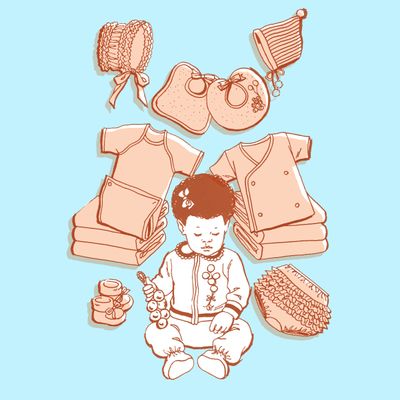
NEW MOM explores the brilliant, terrible, wonderful, confusing realities of first-time motherhood. It’s for anybody who wants to be a new mom, is a new mom, was a new mom, or wants really good reasons to never be a new mom.
When I was pregnant three years ago, I never considered it a one-off. I didn’t take glamorous photos. I didn’t force my husband out for midnight ice cream. Next time I’ll make a bigger deal, I remember thinking. Now, I’m not so sure about a next time. Deciding whether to try for a second child has felt like taking a qualitative question (Is parenthood for me?) and turning it quantitative: Do I want what I have now, but more? This time, I know what it’ll cost.
I love being a mom, and parenting my daughter has brought immeasurable joy into my life. It has also brought measurable changes — costs, say — that are hard to ignore when you’re juggling them every day. That’s why, when I’m asked if I’ll have another, my answer is usually a long sigh and then a list of stressful logistics.
Everyone says when you have another kid your heart grows to fit them — and you have hand-me-downs for the rest. This may account for the “cheaper by the dozen effect” reported in the Washington Post to mean subsequent kids don’t cost quite as much as a first. But you can’t hand down food ($2,845 per kid per year, according to a Department of Agriculture calculator) or medical care ($1,830 per kid per year).
CNN reported in January that a middle class dual-income American family will spend $233,610 to raise a child, based on the same USDA research. It won’t surprise you that this total goes up, substantially, in New York City, so my husband and I pay in child care per year just about what the report says it should cost over a child’s lifetime: $37,378. Once our daughter starts kindergarten, an entire salary will be added back into our cash flow. (A salary that simultaneously feels like too little to acknowledge what caregivers do, while being almost too much to afford.) I’d be lying if I said we aren’t aware of this — practically counting down to it — all the time. It’s hard to forget that if we have another child we start the payment process all over again.
Attempting parenting at all is an exercise in blind optimism. So when I think about the mental labor of parenting, I’m not even wrapping my head around the costs (financial or otherwise) we’d face if a second child were atypical, or if conceiving said child would require reproductive assistance — from $20,000 for IVF to $30,000 for surrogacy — or adoption. Love is supposed to be enough to build a family, but it takes money, too. Is there an amount that would be too much?
There are the actual career implications of growing your family, too. I was lucky to get 12 weeks maternity leave, and to be paid for six, in 2015, after which my whole office MO changed. I went from being one of the last at work every night to sprinting for the elevator at 5 p.m., a crazed fury in my eye if anyone dared ask about my evening plans. (Plans?!) This was to save money on late fees, but also to avoid walking into daycare to find my child, exhausted, with the last caregiver promising her mommy would be next.
Meanwhile, the man who filled in for me had done such a bang-up job that management decided we should just both run my team: my first glimpse of the maternal wall.
Chances are, I’d be making more money if I hadn’t had a baby, hadn’t taken “time off,” and hadn’t had the dip in productivity of my job temporarily becoming half-mine, half a man’s. (We’ve both since moved on.) But research has shown that when new moms lose wages or miss out on salary growth, it follows them throughout their careers. the New York Times recently reported that when a woman has her first child between the ages of 25 and 35, as I did, her pay never recovers.
FMLA laws actually require businesses to allow parents to return to their same or an equivalent job, so it’s hard to imagine that exact scenario playing out again. A bigger concern is not getting leave at all, which is real for me now as a freelancer, and for 12 percent of working parents (only 14 percent can take paid leave, according to Pew research). An acquaintance recently told me the strain of pulling back from work during her complicated pregnancy is why she won’t have another child; her job couldn’t take it.
For me, this juggling act meant productivity like I’d never experienced before. At work I was working. Hard. And inventively. Of course, like many working parents, I’d log more hours on the commute home and then after my daughter went to bed. It hardly felt sustainable then, and I’m still waiting to slow back down. Adding a child — even a gym membership — feels like it would have to occupy hours that don’t exist.
There’s a whole parenting podcast space about the entrepreneurial thinking that life with kids requires. One Bad Mother has a weekly segment on “genius” moments. Longest Shortest Time is compiling a book of “weird parenting wins.” But I got that with one. What if the most genius parenting hack of all is taking advantage of my souped-up mom brain and not busying it with additional kids?
When I see parents with more than one child, one in a carrier and another doing that limp-body-sidewalk thing, I don’t envy them necessarily. I see they have what I have, only more, and my first thought is often how tired they must be. I wonder if they Seamless all their meals, which I already do plenty. I wonder if they fight.
But how much do time and money and stress count after you see your 2-year-old grasp the concept of “brother” and decide she would like one? (Well, she wants to be one, like Daniel Tiger.) And she’s growing so fast, each moment feels like a shooting star.
I can count diapers (about $30/week for a newborn, because we insisted on Seventh Generation, though we’d likely care less about the planet if we did it again). I can count a second car seat and a fourth plane ticket. I can stress about how anyone manages to carry an infant while hand-holding a bigger kid and pushing a grocery cart. But most of that hits at once and then passes, and it doesn’t take into account the “return on investment” — a child — which my husband points out is a crucial part of the cost/benefit analysis.
And then it’s vacations where our kid has someone to play with in the backseat. It’s family struggles when she’ll have someone who is similarly invested and not her parent. It’s all the first words, first “I love you” and first chocolate-bar faces we’d get to have a whole other time. It’s pregnancy, and feeling tiny elbows tickle my ribs. It’s the unmatched privilege of seeing my partner parent, and of growing up in these ways together.
Meanwhile, my daughter has learned the word “sister.” Suffice it to say: We’re still in talks.


